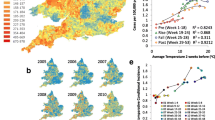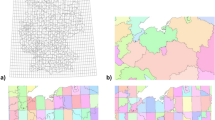Abstract
Previous studies have detected an effect of earlier temperatures on the incidence of campylobacteriosis in humans, but without adjustment for earlier numbers of cases of the disease. We estimated the effect of temperature on the number of cases notified by week in Montreal, Canada, from 1 January 1990 to 26 March 2006, simultaneously with the effect of the numbers of cases notified in the preceding weeks. The current campylobacteriosis count (week 0) was modelled by negative binomial regression, with earlier weekly average temperatures and earlier counts as predictors. Secular trends were accounted for by cubic spline functions and seasonal variations by sine-cosine functions. Indicator variables identified weeks with fewer than 5 working days. In the final statistical model, a 1°C increase in temperature above 10°C during any of weeks −1 to −6 was associated with a 0.8% (95% CI: 0.3% to 1.3%) increase in the current count. For each additional notified case during any of weeks −1 to −5 or −9 to −12, the increase in the current count was approximately 0.5% (95% CI: 0.2% to 1.0%). Thus, earlier temperatures and earlier counts have independent effects, that of temperatures being the larger one. The temperature effect is too small to require short term public health planning. However, in Montreal, an increase in average temperature of the order of 4.5°C, forecast by some for 2055, could produce a 23% increase in incidence, resulting in about 4,000 excess cases per year.




Similar content being viewed by others
References
Adak GK, Meakins SM, Yip H, Lopman BA, O'Brien SJ (2005) Disease risks from foods, England and Wales, 1996–2000. Emerg Infect Dis 11:365–372
Armstrong B (2006) Models for the relationship between ambient temperature and daily mortality. Epidemiology 17:624–631
Bentham G, Langford IH (2001) Environmental temperatures and the incidence of food poisoning in England and Wales. Int J Biometeorol 45:22–26
Bi P, Cameron AS, Zhang Y, Parton KA (2008) Weather and notified Campylobacter infections in temperate and sub-tropical regions of Australia: an ecological study. J Infect 57:317–323
Charron DF, Thomas MK, Waltner-Toews D, Aramini JJ, Edge T, Kent RA, Maarouf AR, Wilson J (2004) Vulnerability of waterborne diseases to climate change in Canada: a review. J Toxicol Environ Health 67(part A):1667–1677
Ekdahl K, Normann B, Andersson Y (2005) Could flies explain the elusive epidemiology of campylobacteriosis? BMC Infect Dis 4:11–14
Fleury M, Charron DF, Holt JD, Allen OB, Maarouf AR (2006) A time series analysis of the relationship of ambient temperature and common bacterial enteric infections in two Canadian provinces. Int J Biometeorol 50:385–391
Greenland S, Pearl J, Robins JM (1999) Causal diagrams for epidemiologic research. Epidemiology 10:37–48
Harrell FR Jr (2001) Regression Modeling Strategies with applications to linear models, logistic regression and survival analysis. Springer, New York
Heymann DL (2004) Control of communicable diseases manual, 18th edn. American Public Health Association, Washington DC
Hunter PR (2003) Climate change and waterborne and vector-borne disease. J Appl Microbiol 94:37S–46S
Kovats RS, Edwards SJ, Charron D, Cowden J, D'Souza RM, Ebi KL, Gauci C, Gerner-Smidt P, Hajat S, Hales S, Hernandez Pezzi G, Kriz B, Kutsar K, McKeown P, Mellou K, Menne B, O'Brien S, van Pelt W, Schmid H (2005) Climate variability and campylobacter infection: an international study. Int J Biometeorol 49:207–214
Lake IR, Gillespie IA, Bentham G, Nichols GL, Lane C, Adak GK, Threlfall EJ (2009) A re-evaluation of the impact of temperature and climate change on foodborne illness. Epidemiol Infect 137:1538–1547
Louis VR, Gillespie IA, O'Brien SJ, Russek-Cohen E, Pearson AD, Colwell RR (2005) Temperature-driven campylobacter seasonality in England and Wales. Appl Environ Epidemiol 71:85–92
Luber P, Bartelt E (2005) Campylobacteriose durch Hähnchenfleisch: Eine quantitative Risikoschätzung. Bundesinstitut für Risikobewertung, Berlin
McMichael AJ, Woodruff RE, Hales S (2006) Climate change and human health: present and future risk. Lancet 367:859–869
Mead PS, Slutsker L, Dietz V, McCaig LF, Bresee JS, Shapiro C, Griffin PM, Tauxe RV (1999) Food-related illness and death in the United States. Emerg Infect Dis 5:607–625
Muggeo VMR (2003) Estimating regression models with unknown break points. Stat Med 22:3055–3071
Naumova EN, Jagai JS, Matyas B, DeMaria A Jr, MacNeill IB, Griffiths JK (2007) Seasonality in six enterically transmitted diseases and ambient temperature. Epidemiol Infect 135:281–292
Nichols G (2005) Fly transmission of Campylobacter. Emerg Infect Dis 11:361–364
Skelly C, Weinstein P (2003) Pathogen survival trajectories: an eco-environmental approach to the modeling of human campylobacteriosis ecology. Environ Health Perspect 111:19–28
Stern NJ, Hiett KL, Alfredsson GA, Kristinsson KG, Reiersen J, Hardardottir H, Briem H, Gunnarsson E, Georgsson F, Lowman F, Berndtson E, Lammerding AM, Paoli GM, Musgrove MT (2003) Campylobacter spp. in Icelandic poultry operations and human disease. Epidemiol Infect 130:23–32
Tam CC, Rodrigues LC, O'Brien SJ, Hajat S (2006) Temperature dependence of reported Campylobacter infection in England, 1989-1999. Epidemiol Infect 134:119–125
Teunis P, Van den Brandhof W, Nauta M, Wagenaar J, Van den Kerkhof H, van Pelt W (2005) A reconsideration of the Campylobacter dose-response relation. Epidemiol Infect 133:583–592
Vellinga A, Van Loock F (2002) The dioxin crisis as experiment to determine poultry-related Campylobacter enteritis. Emerg Infect Dis 8:19–22
Watson RT, Patz J, Gubler DJ, Parson EA, Vincent JH (2005) Environmental health implications of global climate change. J Environ Monit 7:834–843
Acknowledgements
The authors thank Environment Canada for providing the temperature data, Marc-André Bois, Claude Tremblay and François Tessier for their help with data files, and Danielle Ramsay for providing information on chicken meat production. They also thank Lucie Bédard, Michel Fournier, and especially Ben Armstrong for his invaluable advice during the later stages of the study.
Declaration of interest
The research described herein complies with the current laws of Canada. No financial support was received for this study and none of the authors has any financial interest that could be affected by material in this manuscript, or which might have biassed it.
Author information
Authors and Affiliations
Corresponding author
Rights and permissions
About this article
Cite this article
Allard, R., Plante, C., Garnier, C. et al. The reported incidence of campylobacteriosis modelled as a function of earlier temperatures and numbers of cases, Montreal, Canada, 1990–2006. Int J Biometeorol 55, 353–360 (2011). https://doi.org/10.1007/s00484-010-0345-x
Received:
Revised:
Accepted:
Published:
Issue Date:
DOI: https://doi.org/10.1007/s00484-010-0345-x




